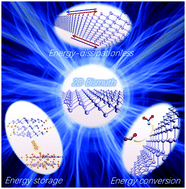当前位置:
X-MOL 学术
›
Chem. Soc. Rev.
›
论文详情
Our official English website, www.x-mol.net, welcomes your
feedback! (Note: you will need to create a separate account there.)
Advances of 2D bismuth in energy sciences.
Chemical Society Reviews ( IF 40.4 ) Pub Date : 2020-01-02 , DOI: 10.1039/c9cs00551j Xuhai Liu 1 , Shengli Zhang , Shiying Guo , Bo Cai , Shengyuan A Yang , Fukai Shan , Martin Pumera , Haibo Zeng
Chemical Society Reviews ( IF 40.4 ) Pub Date : 2020-01-02 , DOI: 10.1039/c9cs00551j Xuhai Liu 1 , Shengli Zhang , Shiying Guo , Bo Cai , Shengyuan A Yang , Fukai Shan , Martin Pumera , Haibo Zeng
Affiliation

|
Since graphene has been successfully exfoliated, two-dimensional (2D) materials constitute a vibrant research field and open vast perspectives in high-performance applications. Among them, bismuthene and 2D bismuth (Bi) are unique with superior properties to fabricate state-of-the-art energy saving, storage and conversion devices. The largest experimentally determined bulk gap, even larger than those of stanene and antimonene, allows 2D Bi to be the most promising candidate to construct room-temperature topological insulators. Moreover, 2D Bi exhibits cyclability for high-performance sodium-ion batteries, and the enlarged surface together with the good electrochemical activity renders it an efficient electrocatalyst for energy conversion. Also, the air-stability of 2D Bi is better than that of silicene, germanene, phosphorene and arsenene, which could enable more practical applications. This review aims to thoroughly explore the fundamentals of 2D Bi and its improved fabrication methods, in order to further bridge gaps between theoretical predictions and experimental achievements in its energy-related applications. We begin with an introduction of the status of 2D Bi in the 2D-material family, which is followed by descriptions of its intrinsic properties along with various fabrication methods. The vast implications of 2D Bi for high-performance devices can be envisioned to add a new pillar in energy sciences. In addition, in the context of recent pioneering studies on moiré superlattices of other 2D materials, we hope that the improved manipulation techniques of bismuthene, along with its unique properties, might even enable 2D Bi to play an important role in future energy-related twistronics.
中文翻译:

二维铋在能源科学中的进展。
由于石墨烯已成功剥离,因此二维(2D)材料构成了一个充满活力的研究领域,并为高性能应用打开了广阔的前景。其中,铋和2D铋(Bi)具有独特的性能,可制造出最先进的节能,存储和转换设备。实验确定的最大体隙(甚至大于锡和锑的体隙)使2D Bi成为构建室温拓扑绝缘体的最有希望的候选者。此外,二维Bi表现出对高性能钠离子电池的可循环性,并且扩大的表面以及良好的电化学活性使其成为用于能量转换的有效电催化剂。而且,二维Bi的空气稳定性要好于硅烯,锗烯,磷烯和砷,可以实现更实际的应用。这篇综述旨在彻底探索2D Bi的基本原理及其改进的制造方法,以进一步弥合其在与能源有关的应用中的理论预测与实验成果之间的差距。我们首先介绍2D Bi在2D材料家族中的状态,然后介绍其固有特性以及各种制造方法。可以预见2D Bi对高性能设备的巨大影响,将为能源科学添加新的支柱。另外,在最近对其他2D材料的波纹超晶格的开创性研究的背景下,我们希望改进的铋操纵技术及其独特的性能,
更新日期:2020-01-02
中文翻译:

二维铋在能源科学中的进展。
由于石墨烯已成功剥离,因此二维(2D)材料构成了一个充满活力的研究领域,并为高性能应用打开了广阔的前景。其中,铋和2D铋(Bi)具有独特的性能,可制造出最先进的节能,存储和转换设备。实验确定的最大体隙(甚至大于锡和锑的体隙)使2D Bi成为构建室温拓扑绝缘体的最有希望的候选者。此外,二维Bi表现出对高性能钠离子电池的可循环性,并且扩大的表面以及良好的电化学活性使其成为用于能量转换的有效电催化剂。而且,二维Bi的空气稳定性要好于硅烯,锗烯,磷烯和砷,可以实现更实际的应用。这篇综述旨在彻底探索2D Bi的基本原理及其改进的制造方法,以进一步弥合其在与能源有关的应用中的理论预测与实验成果之间的差距。我们首先介绍2D Bi在2D材料家族中的状态,然后介绍其固有特性以及各种制造方法。可以预见2D Bi对高性能设备的巨大影响,将为能源科学添加新的支柱。另外,在最近对其他2D材料的波纹超晶格的开创性研究的背景下,我们希望改进的铋操纵技术及其独特的性能,











































 京公网安备 11010802027423号
京公网安备 11010802027423号